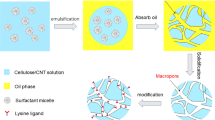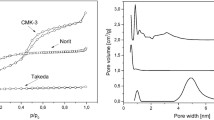Abstract
The high level of low density lipoprotein (LDL) in plasma is the main cause of atherosclerosis. Hemoperfusion is an ideal therapy to lower the level of LDL in human blood system while therapeutic effect is determined by the adsorbent. The adsorbent must have suitable pore structure and specific functional groups. Carbon nanotubes (CNTs) could be a new adsorbent material because CNTs have high specific surface area and they can be modified by a variety of functional groups. Porous carbon composite beads with the CNTs and phenolic resin mixture were synthesized by suspension polymerization, following with carbonization and steam-activation. Then the porous composite beads were sulfonated with a sulfanilic acid anhydrous by diazotization and coupling reaction. The potential application of the sulfonated porous composite beads in adsorbing low density lipoprotein (LDL) from human serum was investigated. The results showed that the sulfonic acid groups on the composite beads could lower LDL levels greatly by electrostatic interaction with electropositive LDL. The higher 20–100 nm pore volume the composite beads had, the more LDL they could adsorb. The 20–100 nm pore volume was enhanced by adding more CNTs and improving CNTs dispersion (ultrasonic crushing). The sulfonated composite beads containing 45 wt% CNTs presented the highest adsorption capacity to LDL 10.46 mg/g, showing a good prospect as LDL adsorbent in hemoperfusion.






Similar content being viewed by others
References
Holvoet P, Harris TB, Tracy RP, Verhamme P, Newman AB, Rubin SM, et al. Association of high coronary heart disease risk status with circulating oxidized LDL in the well-functioning elderly: findings from the health, aging, and body composition study. Arterioscler Thromb Vasc Biol. 2003;23(8):1444–8.
Hiki M, Shimada K, Ohmura H, Kiyanagi T, Kume A, Sumiyoshi K, et al. Serum levels of remnant lipoprotein cholesterol and oxidized low-density lipoprotein in patients with coronary artery disease. J Cardiol. 2009;53(1):108–16.
Brown MS, Goldstein JL. Lowering LDL—not only how low. Science. 2006;311(24):1721–3.
Bambauer R, Schiel R, Latza R. Low-density lipoprotein apheresis: an overview. Ther Apher Dial. 2003;7(4):382–90.
Kobayashi A, Nakatani M, Furuyoshi S, Tani N. In vitro evaluation of dextran sulfate cellulose beads for whole blood infusion low-density lipoprotein-hemoperfusion. Ther Apher. 2002;6(5):365–71.
Tasaki H, Yamashita K, Saito Y, Bujo H, Daida H, Mabuchi H, et al. Low-density lipoprotein apheresis therapy with a direct hemoperfusion column: a Japanese multicenter clinical trial. Ther Apher Dial. 2006;10(1):32–41.
Julius U, Parhofer KG, Heibges A, Kurz S, Klingel R, Geiss HC. Dextran-sulfate-adsorption of atherosclerotic lipoproteins from whole blood or separated plasma for lipid-apheresis-comparison of performance characteristics with DALI and lipidfiltration. J Clin Apher. 2007;22(4):215–23.
Bosch T, Lennertz A, Kordes B, Samtleben W. Low density lipoprotein hemoperfusion by direct adsorption of lipoproteins from whole blood(DALI Apheresis): clinical experience from a single center. Ther Apher. 1999;3(3):209–13.
Bosch T, Lennertz A, Samtleben W. High-efficiency DALI apheresis using 1,250 ml adsorbers in a hypercholesterolemic obese patient: a case report. Ther Apher. 2001;5(5):358–63.
Wendler T, Schilling R, Lennertz A, Sodemann K, Kleophas W, Meßner H, et al. Efficacy and safety of DALI LDL-apheresis at high blood flow rates: a prospective multicenter study. J Clin Apher. 2003;18(4):157–66.
Bosch T, Gahr S, Belschner U, Schaefer C, Lennertz A, Jörg Rammo, et al. Direct adsorption of low-density lipoprotein by DALI-LDL-apheresis: results of a prospective long-term multicenter follow-up covering 12291 sessions. Ther Apher Dial. 2006;10(3):210–8.
Hevonoja T, Pentikainen MO, Hyvonen MT, Kovanen PT, Ala-Korpela M. Structure of low density lipoprotein (LDL) particles: basis for understanding molecular changes in modified LDL. Biochim Biophys Acta. 2000;1488(3):189–210.
Sandeman SR, Howell CA, Phillips GJ, Lloyda AW, Davies JG, Mikhalovskya S, et al. Assessing the in vitro biocompatibility of a novel carbon device for the treatment of sepsis. Biomaterials. 2005;26:7124–31.
Howell CA, Sandemana SR, Phillips GJ, Lloyda AW, Davies JG, Mikhalovskya SV, et al. The in vitro adsorption of cytokines by polymer-pyrolysed carbon. Biomaterials. 2006;27:5286–91.
Yushina G, Hoffmana EN, Barsouma MW, Gogotsi Y, Howell CA, Sandeman SR, et al. Mesoporous carbide-derived carbon with porosity tuned for efficient adsorption of cytokines. Biomaterials. 2006;27:5755–62.
Sandeman SR, Howell CA, Mikhalovsky SV, Phillips GJ, Lloyd AW, Davies JG, et al. Inflammatory cytokine removal by an activated carbon device in a flowing system. Biomaterials. 2008;29:1638–44.
Yachamaneni S, Yushin G, Yeon SH, Gogotsi Y, Howell C, Sandeman S, et al. Mesoporous carbide-derived carbon for cytokine removal from blood plasma. Biomaterials. 2010;31:4789–94.
Yang QH, Hou PX, Bai S, Wang MZ, Cheng HM. Adsorption and capillarity of nitrogen in aggregated multi-walled carbon nanotubes. Chem Phys Lett. 2001;345(1–2):18–24.
Ye C, Gong QM, Lu FP, Liang J. Adsorption of uraemic toxins on carbon nanotubes. Sep Purif Technol. 2007;58(1):2–6.
Tang T, Liu XL, Li C, Lei B, Zhang DH, Rouhanizadeh M, et al. Complementary response of In2O3 nanowires and carbon nanotubes to low-density lipoprotein chemical gating. Appl Phys Lett. 2005;86(10):1–3.
Tiwari A, Gong SQ. Electrochemical study of chitosan-SiO2-MWNT composite electrodes for the fabrication of cholesterol biosensors. Electroanalysis. 2008;20(19):2119–26.
Dhand C, Arya SK, Datta M, Malhotra BD. Polyaniline–carbon nanotube composite film for cholesterol biosensor. Anal Biochem. 2008;383:194–9.
Solanki PR, Kaushik A, Ansari AA, Tiwari A, Malhotra BD. Multi-walled carbon nanotubes/sol–gel-derived silica/chitosan nanobiocomposite for total cholesterol sensor. Sens Actuators B. 2009;137:727–35.
Stefan R, Dorota LWP. Application of mass transfer coefficient approach for ranking of active carbons designed for hemoperfusion. Carbon. 2004;42(11):2139–46.
Malik DJ, Warwick GL, Mathieson I, Hoenich NA, Streat M. Structured carbon haemoadsorbents for the removal of middle molecular weight toxins. Carbon. 2005;43(11):2317–29.
Peter J, Dowding BV. Suspension polymerization to form polymer beads. Colloid Surf A. 2000;161(2):259–69.
Stephenson JJ, Hudson JL, Azad S, Tour JM. Individualized single walled carbon nanotubes from bulk material using 96% sulfuric acid as solvent. Chem Mater. 2006;18(2):374–7.
Eklund PC, Holden JM, Jishi RA. Vibrational modes of carbon nanotubes; spectroscopy and theory. Carbon. 1995;33(7):959–72.
Marquez AGC, Rodriguez LMT, Rojas AM. Synthesis of fully and partially sulfonated polyanilines derived from ortanilic acid: an electrochemical and electromicrogravimetric study. Electrochim Acta. 2007;52:5294–303.
Delhaes P, Couzi M, Trinquecoste M, Dentzer J, Hamidou H, Vix-Guterl C. A comparison between Raman spectroscopy and surface characterizations of multiwall carbon nanotubes. Carbon. 2006;44(14):3005–13.
Nora G, Eda Y, Thomas G, Andreas L, Wilfried W, Simone K, et al. XPS and NEXAFS studies of aliphatic and aromatic amine species on functionalized surfaces. Surf Sci. 2009;603:2849–60.
Huang D, Xiao ZD, Gu JH, Huang NP, Yuan CW. TiO2 thin films formation on industrial glass through self-assembly processing. Thin Solid Films. 1997;305:110–5.
Cheng Y, Wang SQ, Yu YT, Yuan Y. In vitro, in vivo studies of a new amphiphilic adsorbent for the removal of low-density lipoprotein. Biomaterials. 2003;24:2189–94.
Wang SQ, Yu YT, Cui T, Cheng Y. A novel amphiphilic adsorbent for the removal of low-density lipoprotein. Biomaterials. 2003;24:2799–802.
Li HT, Zhang YM, Chen XF, Shi KY, Yuan Z, He BL, et al. Synthesis and adsorption aspect of crosslinked PVA-based blood compatible adsorbents for LDL apheresis. React Funct Polym. 2004;58:53–63.
Li F, Cheng GX, Liang SP. Synthesis and characterization of heparin immobilized PAN-based resin. Polym Bull. 2006;57:261–7.
Wang SQ, Li CM, Guo XJ, Yu YT, Wang WC. Interaction study of LDL with charged ligands for effective LDL-C removing adsorbents. React Funct Polym. 2008;68:261–7.
Acknowledgments
This research was supported by the Natural Science Foundation of China (No. 50602026).
Author information
Authors and Affiliations
Corresponding author
Rights and permissions
About this article
Cite this article
Lu, Y., Gong, Q., Lu, F. et al. Preparation of sulfonated porous carbon nanotubes/activated carbon composite beads and their adsorption of low density lipoprotein. J Mater Sci: Mater Med 22, 1855–1862 (2011). https://doi.org/10.1007/s10856-011-4368-6
Received:
Accepted:
Published:
Issue Date:
DOI: https://doi.org/10.1007/s10856-011-4368-6




